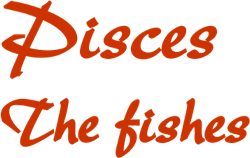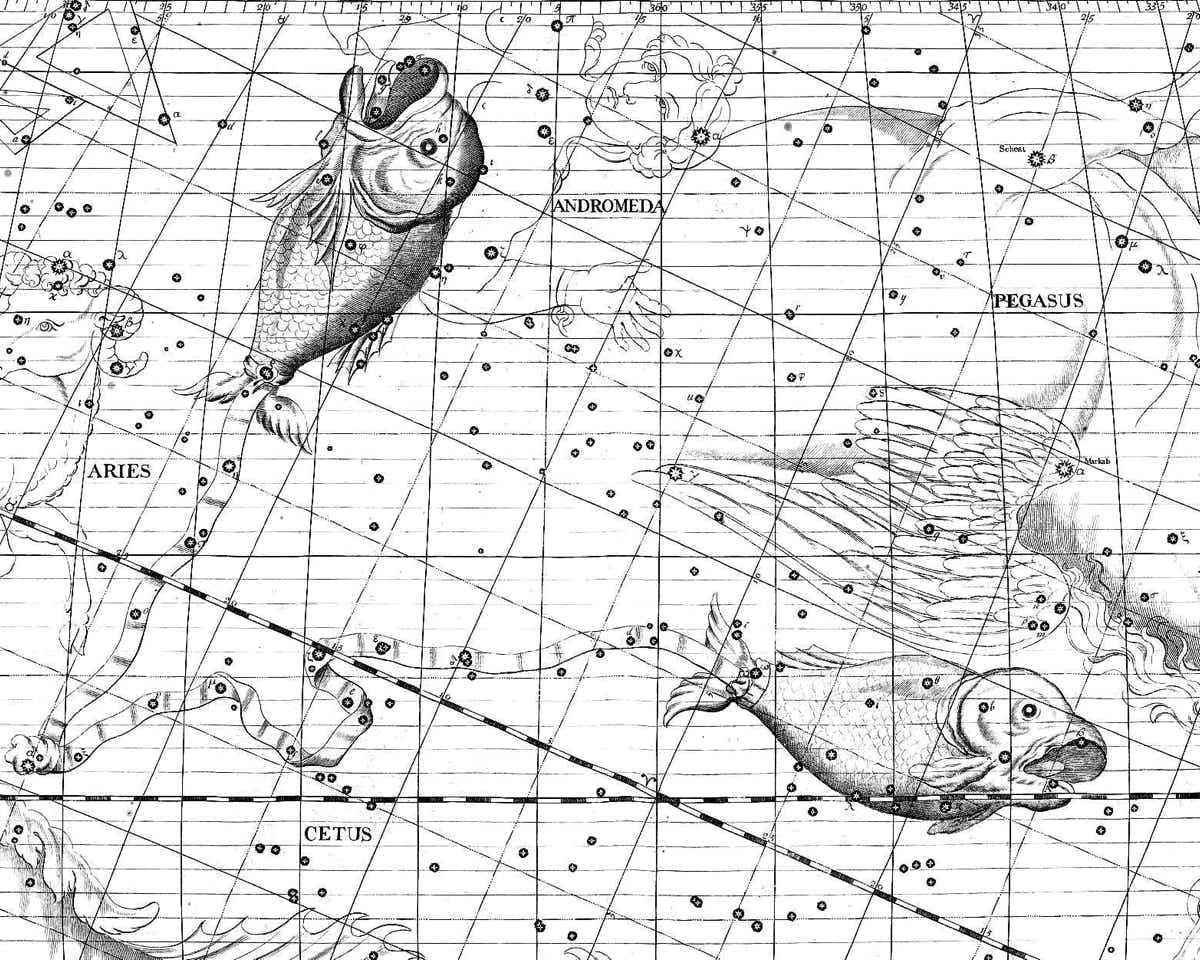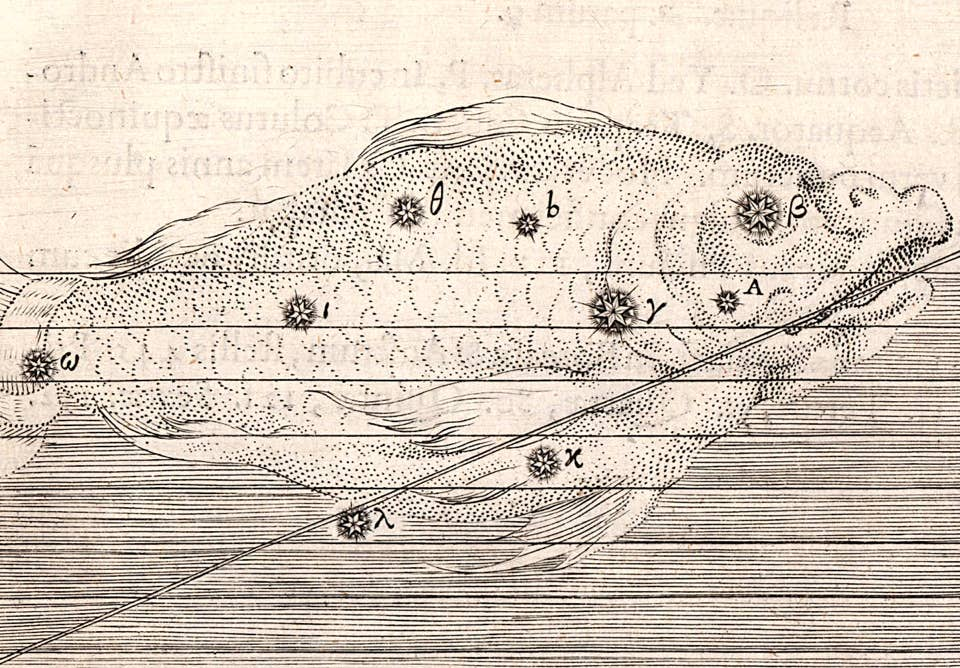
Genitive: Piscium
Abbreviation: Psc
Size ranking: 14th
Origin: One of the 48 Greek constellations listed by Ptolemy in the Almagest
Greek name: Ἰχθύες (Ichthyes)
The mythological events concerning this constellation are said to have taken place around the Euphrates river, a strong indication that the Greeks inherited this constellation from the Babylonians. The story follows an early episode in Greek mythology, in which the gods of Olympus had defeated the Titans and the Giants in a power struggle. Mother Earth, also known as Gaia, had another nasty surprise in store for the gods. She coupled with Tartarus, the lowest region of the Underworld where Zeus had imprisoned the Titans, and from this unlikely union came Typhon, the most awful monster the world had ever seen.
According to Hesiod in the Theogony, Typhon had a hundred dragon’s heads from which black tongues flicked out. Fire blazed from the eyes in each of these heads, and from them came a cacophony of sound: sometimes ethereal voices which only the gods could understand, while at other times Typhon bellowed like a bull, roared like a lion, yelped like puppies, or hissed like a nest of snakes.
Gaia sent this fearsome monster to attack the gods. Pan saw him coming and alerted the others with a shout. Pan himself jumped into the river and changed his form into a goat-fish, represented by the constellation Capricornus, also inherited from the Babylonians.
A cord joins the tails of Pisces, the two fish; the star Alrescha (Alpha Piscium) lies where the two parts of the cord are knotted together, near the border with Cetus. This depiction is from the Atlas Coelestis of John Flamsteed (1729). The horizontal dashed line on the chart passing through the southerly fish is the celestial equator, and the diagonal dashed line is the Sun’s annual path, the ecliptic. Click for the depictions of the constellation on the atlases of Johann Bode and Johannes Hevelius.
The goddess Aphrodite and her son Eros took cover among the reeds on the banks of the Euphrates, but when the wind rustled the undergrowth Aphrodite became fearful. Holding Eros in her lap she called for help to the water nymphs and leapt into the river. In one version of the story, two fish swam up and carried Aphrodite and Eros to safety on their backs, although in another version the two refugees were themselves changed into fish. The mythologists said that because of this story the Syrians would not eat fish, regarding them as gods or the protectors of gods.
An alternative story, given by Hyginus in the Fabulae, is that an egg fell into the Euphrates and was rolled to the shore by two fish. Doves sat on the egg and from it hatched Aphrodite who, in gratitude, put the fish in the sky. Eratosthenes had yet another explanation: he wrote that the two fish represented by Pisces were offspring of the much larger fish that is represented by the constellation Piscis Austrinus. When the goddess Derceto fell into a lake near Bambyce in northern Syria, she was rescued by the large fish; she placed this fish and its two youngsters in the sky as Piscis Austrinus and Pisces, respectively.
The Greek name for the constellation was Ἰχθύες (Ichthyes), as given by Ptolemy in the Almagest; Pisces is the Latin equivalent.
Stars of Pisces and the connecting cord
In the sky, the two fish of Pisces are represented swimming at right angles to each other, one northwards and the other westwards along the celestial equator. The body of the westward-swimming fish is easy enough to pick out, containing a loop of seven stars called the Circlet south of the Square of Pegasus. The northbound fish is more obscure, consisting of a scattering of stars between Aries and Pegasus.
The tails of the two fish are joined by a cord or ribbon marked out by a snaking chain of stars, ten of which have Bayer designations: Delta, Epsilon, Zeta, Mu, Nu, Xi, Alpha, Omicron, Pi, and Eta (see here for Bayer’s chart). The Greeks offered no good explanation for this cord, but according to the historian Paul Kunitzsch the Babylonians visualized a pair of fish joined by a cord in this area, so evidently the Greeks borrowed this idea although the significance of the cord was lost. On Johann Bode’s atlas the cord joining the two fish is labelled Linum Piscium, as though it were a sub-constellation, while Johannes Hevelius divided the cord into a northern half, Linum Boreum, and a southern one, Linum Austrinum – see here for their respective depictions.
Pisces is a disappointingly faint constellation, its brightest stars being of only fourth magnitude. Alpha Piscium, magnitude 3.8, is called Alrescha from the Arabic name al-rishā meaning ‘the cord’, lying where the lines joining the two fish are knotted together. The brightest star in the constellation is Eta Piscium, magnitude 3.6, which lies in the connecting cord near the tail of the northerly fish.
The vernal equinox
Despite its faintness Pisces is notable because it contains the point at which the Sun crosses the celestial equator into the northern hemisphere on March 20 each year. This point, called the vernal equinox, lay in Aries in Greek times but has since moved into Pisces because of a slow wobble of the Earth on its axis called precession. Even so, it is still sometimes called the first point of Aries. Currently the vernal equinox lies south of the Square of Pegasus, near the Circlet, but the continuing effect of precession will carry it into Aquarius around the year 2597.
Chinese associations
Chinese astronomers knew the line of seven stars from Alpha to Delta Piscium as Waiping, a fence to screen off the pigsty of Tianhun which lay south of it in Cetus. Five stars including Eta Piscium formed Yougeng, representing a livestock manager. A zig-zagging chain of five stars from Beta to Iota or Omega Piscium formed Pili, a thunderclap or thunderbolt; to its south, four stars including Lambda and Kappa Piscium formed Yunyu, cloud and rain (Leidian, representing thunder and lightning, lay over the border to the north in Pegasus, completing the stormy scene).
In the north of the constellation, seven stars including Chi, Phi, Upsilon, and Tau Piscium formed the southern part of a loop-shaped figure called Kui, after which the 15th lunar mansion was named, usually known in English as the Legs mansion; the greater part of Kui lay within present-day Andromeda. A quadrilateral of four stars in southernmost Pisces (27, 29, 30, and 33 Piscium) marked the eastern end of the constellation Leibizhen, a chain of fortifications, which crossed Aquarius into Capricornus.
© Ian Ridpath. All rights reserved
The Circlet of stars in Pisces, seen on Johann Bayer’s Uranometria. In clockwise order, Bayer labelled the stars Gamma, Kappa, Lambda, Iota, Theta, and b. The star b is now known by the Flamsteed number 7. A seventh star, the 5th-magnitude variable TX (or 19) Piscium, is now also considered part of the Circlet but was not shown by Bayer.




